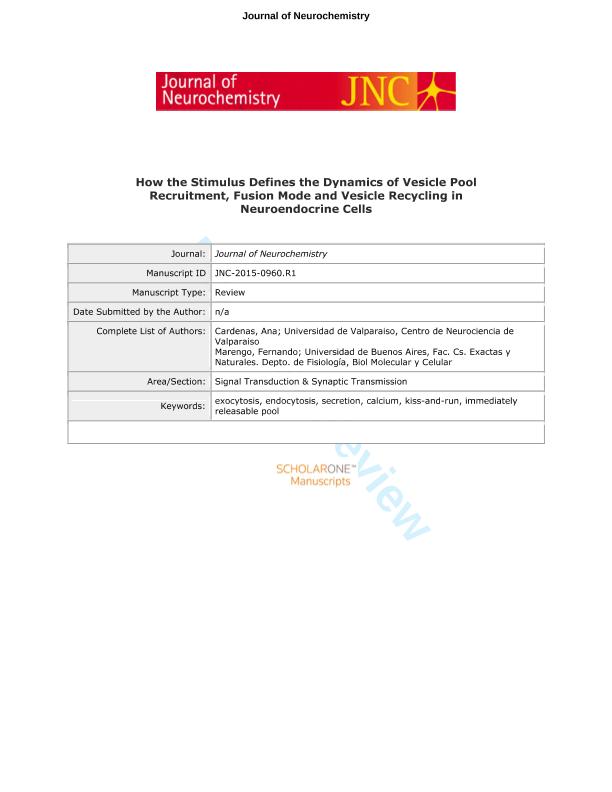Mostrar el registro sencillo del ítem
dc.contributor.author
Cárdenas, Ana María
dc.contributor.author
Marengo, Fernando Diego

dc.date.available
2018-05-11T21:10:58Z
dc.date.issued
2016-06
dc.identifier.citation
Cárdenas, Ana María; Marengo, Fernando Diego; How the stimulus defines the dynamics of vesicle pool recruitment, fusion mode, and vesicle recycling in neuroendocrine cells; Wiley Blackwell Publishing, Inc; Journal of Neurochemistry; 137; 6; 6-2016; 867-879
dc.identifier.issn
0022-3042
dc.identifier.uri
http://hdl.handle.net/11336/44998
dc.description.abstract
The pattern of stimulation defines important characteristics of the secretory process inneurons and neuroendocrine cells, including the pool of secretory vesicles beingrecruited, the type and amount of transmitters released, the mode of membrane retrievaland the mechanisms associated with vesicle replenishment. This review analyzes themechanisms that regulate these processes in chromaffin cells, as well as in otherneuroendocrine and neuronal models. A common factor in these mechanisms is thespatial and temporal distribution of the Ca2+ signal generated during cell stimulation.For instance, neurosecretory cells and neurons have pools of vesicles with differentlocations with respect to Ca2+ channels, and those pools are therefore differentiallyrecruited following different patterns of stimulation. In this regard, a brief stimulus willinduce the exocytosis of a small pool of vesicles that is highly coupled to voltagedependentCa2+ channels, whereas longer or more intense stimulation will provoke aglobal Ca2+ increase, promoting exocytosis irrespective of vesicle location. The patternof stimulation, and therefore the characteristics of the Ca2+ signal generated by thestimulus, also influences the mode of exocytosis and the type of endocytosis. Indeed,low frequency stimulation favors kiss-and-run exocytosis and clathrin-independent fastendocytosis, whereas higher frequencies promote full fusion and clathrin-dependentendocytosis. This latter type of endocytosis is accelerated at high frequency stimulation.Synaptotagmins, calcineurin, dynamin, complexin, and actin remodeling, appear to beinvolved in the mechanisms that determine the response of these processes to Ca2+.
dc.format
application/pdf
dc.language.iso
eng
dc.publisher
Wiley Blackwell Publishing, Inc

dc.rights
info:eu-repo/semantics/openAccess
dc.rights.uri
https://creativecommons.org/licenses/by-nc-sa/2.5/ar/
dc.subject
Exocytosis
dc.subject
Endocytosis
dc.subject
Calcium
dc.subject
Secretiion
dc.subject.classification
Inmunología

dc.subject.classification
Medicina Básica

dc.subject.classification
CIENCIAS MÉDICAS Y DE LA SALUD

dc.title
How the stimulus defines the dynamics of vesicle pool recruitment, fusion mode, and vesicle recycling in neuroendocrine cells
dc.type
info:eu-repo/semantics/article
dc.type
info:ar-repo/semantics/artículo
dc.type
info:eu-repo/semantics/publishedVersion
dc.date.updated
2018-05-11T20:54:53Z
dc.journal.volume
137
dc.journal.number
6
dc.journal.pagination
867-879
dc.journal.pais
Reino Unido

dc.journal.ciudad
Londres
dc.description.fil
Fil: Cárdenas, Ana María. Universidad de Valparaíso; Chile
dc.description.fil
Fil: Marengo, Fernando Diego. Consejo Nacional de Investigaciones Científicas y Técnicas. Oficina de Coordinación Administrativa Ciudad Universitaria. Instituto de Fisiología, Biología Molecular y Neurociencias. Universidad de Buenos Aires. Facultad de Ciencias Exactas y Naturales. Instituto de Fisiología, Biología Molecular y Neurociencias; Argentina
dc.journal.title
Journal of Neurochemistry

dc.relation.alternativeid
info:eu-repo/semantics/altIdentifier/url/https://onlinelibrary.wiley.com/doi/abs/10.1111/jnc.13565
dc.relation.alternativeid
info:eu-repo/semantics/altIdentifier/doi/http://dx.doi.org/10.1111/jnc.13565
Archivos asociados
